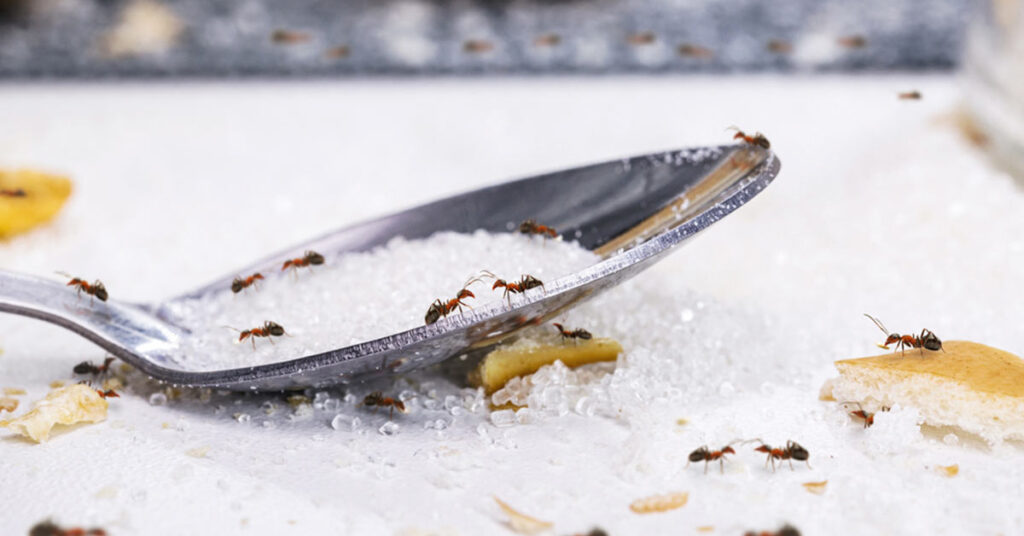If you’re dealing with a flying ant infestation, it’s essential to know how to effectively get rid of them. Flying ants can be a nuisance, particularly when they invade your home or outdoor spaces. However, with the right knowledge and strategies, you can successfully eliminate them and regain control over your environment. From preventive measures to targeted treatments, this guide will provide you with valuable insights and practical solutions on how to get rid of flying ants and prevent future infestations.

Understanding Flying Ants
Flying ants are reproductive ants that have wings and are capable of flight. They are not a separate species but rather winged individuals of certain ant species. Flying ants play a crucial role in the reproduction and expansion of ant colonies.
How To Identify Flying Ants?
Flying ants can be identified by their distinct physical characteristics. They have two pairs of wings, with the front pair being larger than the hind pair. Unlike termites, their wings are of different lengths. Flying ants also have a constricted waist, elbowed antennae, and bent or curved antennae segments. The presence of winged ants indoors or in large numbers outdoors is a clear indication of flying ants.
What Is The Life Cycle Of Flying Ants?
The life cycle of flying ants spans several weeks, beginning with the highly anticipated nuptial flight. Typically, the mating flights of flying ants occur during specific days or weeks, which can vary depending on the species and geographic location.
For example, some species may have their nuptial flights in late spring or early summer, while others may have them in late summer or early autumn. During this period, male and female flying ants take to the air to mate. Once mating is complete, the fertilized females shed their wings and embark on the next stage of their life cycle as potential queens. They search for suitable locations to establish new colonies, where they lay eggs. The eggs then hatch into larvae, which undergo metamorphosis and develop into pupae. After a period of time, the adult worker ants emerge from the pupae, contributing to the tasks and responsibilities within the ant colony.
Are Flying Ants Harmful To Humans?
Flying ants are generally not harmful to humans. They do not pose a direct threat or cause physical harm. However, their presence in large numbers can be a nuisance, especially when they enter homes or outdoor living spaces. Some people may also experience anxiety or discomfort due to their swarming behavior.
-
Best Overall
 Save $50 on your first recurring service today with code GET50
Save $50 on your first recurring service today with code GET50 -
Best for Termites
 Save $50 on pest control services with code SAVE50 at checkout
Save $50 on pest control services with code SAVE50 at checkout -
Best for Bed Bugs
 Get a free estimate on pest control services for your home
Get a free estimate on pest control services for your home -
Best for Wildlife Removal
 Call For A Fast & FREE Phone Estimate Today
Call For A Fast & FREE Phone Estimate Today -
Best for Natural Treatment
 Get $100 Off Your Termite Treatment Service
Get $100 Off Your Termite Treatment Service
What Is The Mating Season Of Flying Ants?
The mating season of flying ants varies depending on the species and environmental conditions. While there is no universal mating season for all flying ants, they typically emerge during specific days or weeks within a given timeframe. The exact timing of the mating flight can be influenced by factors such as temperature, humidity, and daylight hours.
In temperate regions, the mating season of flying ants often occurs during the summer months when conditions are favorable. This period usually coincides with warm and humid weather, which is ideal for the flight and dispersal of winged ants. The precise dates of the mating season can differ between species and even within the same species across different regions.
Do Flying Ants Bite Or Sting?
Flying ants do have the ability to bite, but they rarely do so. Their primary focus during the mating flight is reproduction and finding a suitable location to establish new colonies. Unlike certain species of stinging ants, flying ants do not possess a venomous sting and are not known to inflict painful stings.
What Are The Common Species Of Flying Ants?
There are several common species of flying ants, including the black garden ant, the flying ant of the pharaoh ant, the wood ant, and the pavement ant. These species can be found in various habitats, including gardens, forests, and urban areas.
Flying Ants Vs Termites
Flying ants and termites are often mistaken for each other due to their similar appearance during their winged stage. By closely observing these distinguishing features, one can identify whether they are dealing with flying ants or termites. It is crucial to accurately differentiate between the two, as their treatment and control methods may vary. Consulting with a professional pest control service can provide expert identification and guidance for the effective management of either flying ants or termites. There are several key differences that can help distinguish between the two:
Body Shape
Flying ants have a distinct body shape with a constricted waist, elbowed antennae, and bent or curved antennae segments. In contrast, termites have a straight and thick waist, straight antennae, and relatively uniform body width.
Wing Length and Vein Pattern
The wings of flying ants are of different lengths, with the front pair being larger than the hind pair. Moreover, the wings of flying ants have a noticeable vein pattern. In termites, all four wings are typically of equal length, and the wings have a more uniform texture without prominent vein patterns.
Antennae Shape
The antennae of flying ants are elbowed or have bent segments, providing a distinct appearance. Termites, on the other hand, have straight antennae without any bends or curves.
Habitat and Behavior
Flying ants and termites also differ in their habitat preferences and behaviors. Flying ants are typically found in terrestrial environments, nesting in soil, wood, or other suitable structures. They are primarily foragers for food and expand existing colonies. Termites, on the other hand, are known for their ability to break down and digest cellulose, found in wood and plant materials. They often build extensive underground or above-ground colonies, and their feeding habits can cause significant damage to wooden structures.
The Attraction And Dangers Of Flying Ants
What Attracts Flying Ants?
Flying ants are attracted to certain conditions and stimuli that signal favorable environments for their mating flights and colony establishment. They are particularly drawn to factors such as warm and humid weather, typically during the summer months, which triggers their emergence. Additionally, flying ants are attracted to food sources, especially sugary substances like spilled food, fruits, and sweet beverages. They may also be attracted to artificial lights and follow scent trails laid down by other ants. Minimizing these attractants, such as practicing proper sanitation and keeping food sources sealed, can help reduce the attraction of flying ants to your surroundings.
Can Flying Ants Damage The House Structure?
Unlike termites, flying ants do not pose significant structural damage to houses or buildings. While flying ants may enter homes during their mating flights, their presence is usually temporary and limited to the period of the nuptial flight.
However, it is worth noting that flying ants are still considered a nuisance pest. They can cause annoyance and discomfort, especially when they swarm indoors. Additionally, if flying ants find suitable conditions and access to food sources, they may establish colonies within the structure, leading to potential ant infestations.
To prevent flying ants from entering your home and potentially establishing colonies, it is important to seal off any possible entry points, such as gaps, cracks, and openings in doors, windows, and foundations. Regular inspections and maintenance can help identify and address such entryways.
DIY And Natural Solutions For Flying Ants
What Are Natural Ways To Get Rid Of Flying Ants?
When it comes to getting rid of flying ants naturally, there are several effective methods you can try. First, focus on removing their food sources by practicing good sanitation and promptly cleaning up spills or crumbs. Sealing entry points, such as cracks and gaps, can also prevent their access into your home.
Additionally, you can use natural repellents like vinegar, which can be mixed with water and sprayed in areas where flying ants are present. Identify areas where flying ants are active, such as windowsills, doorways, or other entry points, and spray the vinegar solution directly onto these surfaces. You can also spray it along ant trails or areas where they congregate. Vinegar’s strong smell acts as a repellent, discouraging flying ants from entering your home or deterring them from specific areas. Peppermint oil is another option as it emits a strong scent that repels ants.
How To Use Borax To Get Rid Of Flying Ants?
Borax can also be used as a natural solution to eliminate flying ants. Mix equal parts of borax and powdered sugar to create a bait mixture. The sugar acts as an attractant while the borax acts as a slow-acting toxin. Place small amounts of the mixture in shallow dishes or bottle caps near areas where flying ants are active or along their pathways. The ants will be attracted to the bait, consume it, and carry it back to their colonies, effectively eliminating the population over time.
Can You Use DIY Traps To Capture And Kill Flying Ants?
Yes, DIY traps can be effective in capturing and killing flying ants. You can create simple traps using readily available household items. One method is to fill a shallow container with soapy water and place a light source, such as a lamp or candle, above it. Flying ants are attracted to the light and will be lured into the trap, where they will drown in the soapy water. Another option is to create a sticky trap using adhesive tapes or sticky substances, placing them in areas where flying ants are active. As the ants come into contact with the trap, they will get stuck and eventually perish.
How To Make A Homemade Flying Ant Trap?
To make a homemade flying ant trap, you will need a shallow container, such as a plate or jar lid, and a sweet liquid bait. Fill the container with the bait, which can be a mixture of sugar water, honey, or fruit juice. Add a few drops of dish soap to the bait, as it will break the surface tension and prevent the ants from escaping. Place the trap in areas where flying ants are prevalent or along their flight paths. The flying ants will be attracted to the bait, enter the container, and drown due to the soapy liquid.
Can Essential Oils Help Repel Flying Ants?
Essential oils have been found to be effective in repelling flying ants due to their strong scents. Peppermint oil, spearmint oil, citrus oil (such as lemon or orange), and tea tree oil are commonly used for this purpose. You can create a natural ant repellent spray by diluting a few drops of essential oil with water in a spray bottle and then spraying it in areas where flying ants are active or where they may enter your home. Alternatively, you can soak cotton balls in the essential oil and place them strategically around your home to deter flying ants. The strong aroma of these essential oils acts as a natural deterrent, making your home less attractive to flying ants and helping to keep them at bay.
Commercial Solutions And Pest Control Services
When dealing with flying ant infestations, commercial solutions, and pest control services can provide effective and professional assistance. Commercial products specifically designed for flying ant control offer convenience and targeted treatment options. In this section, we will explore the range of commercial products available, the benefits of hiring pest control services, the associated costs, and the effectiveness of these approaches in getting rid of flying ants.
What Commercial Products Are Available To Kill Flying Ants?
There are several commercial products available in the market that are highly effective in killing flying ants. One popular option is “Raid Flying Insect Killer,” an aerosol spray specifically formulated to target flying insects, including ants. Another effective product is “Terro Liquid Ant Baits,” which are pre-filled bait stations containing a sweet liquid that attracts flying ants. Once consumed, the bait disrupts the ant’s nervous system and eliminates the entire colony.
Additionally, “Ortho Home Defense Insect Killer Granules” are granular insecticide products that can be scattered in outdoor areas infested with flying ants. These granules create a barrier of protection, killing ants upon contact. It is important to carefully read and follow the instructions provided with these commercial products for safe and effective application.
Can Pest Control Services Help With Flying Ant Infestations?
Yes, pest control services can assist in dealing with flying ant infestations. Professional pest control technicians have the expertise and experience to identify the source of the infestation, determine the appropriate treatment methods, and effectively eliminate the flying ant problem. They may use a combination of techniques such as insecticide sprays, baits, and targeted treatments to address the infestation. Pest control services can provide a more comprehensive and tailored approach to flying ant control, especially in cases of severe or persistent infestations.
What Is The Cost Of Hiring A Pest Control Service To Eliminate Flying Ants?
The cost of hiring a pest control service to eliminate flying ants can vary depending on several factors. The size of the infestation, the location of the property, and the extent of the treatment needed all play a role in determining the cost. On average, the price range for professional pest control services for flying ant infestations can be between $150 and $300.
It’s important to note that prices may vary significantly depending on the specific pest control company, their expertise, and the methods they employ. It is recommended to obtain quotes from multiple reputable pest control services and compare their prices and services before making a decision.
How Effective Is A Pest Control Service In Getting Rid Of Flying Ants?
Professional pest control services are generally effective in getting rid of flying ant infestations. Pest control technicians are trained to identify the species of flying ants, locate their nests or colonies, and employ appropriate treatment methods to eliminate them. They have access to commercial-grade insecticides and specialized equipment, which can be more potent and efficient compared to consumer-grade products. Additionally, pest control services may offer follow-up visits to ensure that the infestation is completely eradicated and provide recommendations for preventive measures to avoid future infestations.
Can You Use Insecticides For Flying Ant Control, And How Safe Are They?
Insecticides can be used for flying ant control, and their effectiveness and safety depend on the specific product and proper application. It is essential to carefully read and follow the instructions provided with the insecticide, including dosage, application methods, and safety precautions. Some insecticides may be formulated specifically for flying ants, while others may have broader efficacy against multiple ant species. It’s important to choose an insecticide labeled for flying ants and to use it only as directed. When using insecticides, it’s advisable to keep children and pets away from treated areas until the product has dried or as specified on the label. If unsure about the proper use or concerned about the potential risks, consulting with a professional pest control service is recommended.
-
Best Overall
 Save $50 on your first recurring service today with code GET50
Save $50 on your first recurring service today with code GET50 -
Best for Termites
 Save $50 on pest control services with code SAVE50 at checkout
Save $50 on pest control services with code SAVE50 at checkout -
Best for Bed Bugs
 Get a free estimate on pest control services for your home
Get a free estimate on pest control services for your home -
Best for Wildlife Removal
 Call For A Fast & FREE Phone Estimate Today
Call For A Fast & FREE Phone Estimate Today -
Best for Natural Treatment
 Get $100 Off Your Termite Treatment Service
Get $100 Off Your Termite Treatment Service
Preventive Measures And Special Cases
How To Prevent Flying Ants From Invading Your Home?
To prevent flying ants from invading your home, it is crucial to take preventive measures. Start by sealing any cracks or gaps in your walls, windows, and doors to eliminate potential entry points. Keep your living spaces clean and free of food debris, as ants are attracted to food sources. Store food in airtight containers to prevent access. Additionally, maintain proper outdoor hygiene by regularly cleaning garbage cans and ensuring they have tightly sealed lids. Trim vegetation and tree branches that may come in contact with your home, as they can serve as bridges for ants. Lastly, consider using ant repellents or deterrents such as cinnamon, vinegar, or essential oils near entry points to discourage ants from entering.
How To Keep Flying Ants Out Of The Pool?
To keep flying ants out of your pool, start by maintaining proper pool hygiene. Regularly clean the pool, remove debris, and keep the water properly chlorinated. Additionally, make sure the pool cover is securely fastened when not in use. Consider installing an automatic pool cover to further prevent access. If you notice flying ants in the area surrounding your pool, address any nearby ant colonies promptly. Remove potential food sources such as fallen fruits, sugary substances, or spilled drinks. If necessary, consult with a professional pest control service for targeted treatment of ant colonies in the vicinity.
How Do I Get Rid Of Flying Ants In My Lawn?
To get rid of flying ants in your lawn, it’s important to address the underlying ant colonies. Start by identifying ant hills or nests in your lawn and apply appropriate ant control measures such as applying ant bait or granular insecticides specifically designed for outdoor use. Follow the instructions provided with the products for safe and effective application. It may be necessary to repeat the treatment over several weeks to ensure complete eradication of the ant colonies. Additionally, practicing good lawn hygiene by regularly mowing the grass, removing fallen leaves and debris, and keeping the lawn well-watered can help deter ants from establishing colonies in the first place.
How To Prevent Flying Ants From Coming Into Your House Through Windows?
To prevent flying ants from entering your house through windows, you can take several precautions. Install window screens or use mesh netting to create a physical barrier that prevents ants from entering while still allowing airflow. Ensure that windows are properly sealed, closing any gaps or cracks. Use weatherstripping or caulk to seal any openings around the window frames. Keep windows closed when possible, especially during peak flying ant seasons.
Furthermore, avoid leaving food or sugary substances near windows, as they can attract ants. Regularly clean and maintain window sills, removing any food debris or ant trails. By implementing these preventive measures, you can significantly reduce the likelihood of flying ants entering your home through windows.
Conclusion
Getting rid of flying ants requires a combination of preventive measures, targeted treatments, and proper hygiene practices. By identifying and addressing the underlying ant colonies, implementing natural or commercial solutions, and maintaining a clean and ant-unfriendly environment, you can effectively eliminate flying ants from your home, lawn, and other areas. It’s important to be proactive and take prompt action to prevent infestations and protect your living spaces from the nuisance and potential damage caused by flying ants. With the right strategies and persistence, you can successfully get rid of flying ants and enjoy a pest-free environment.




